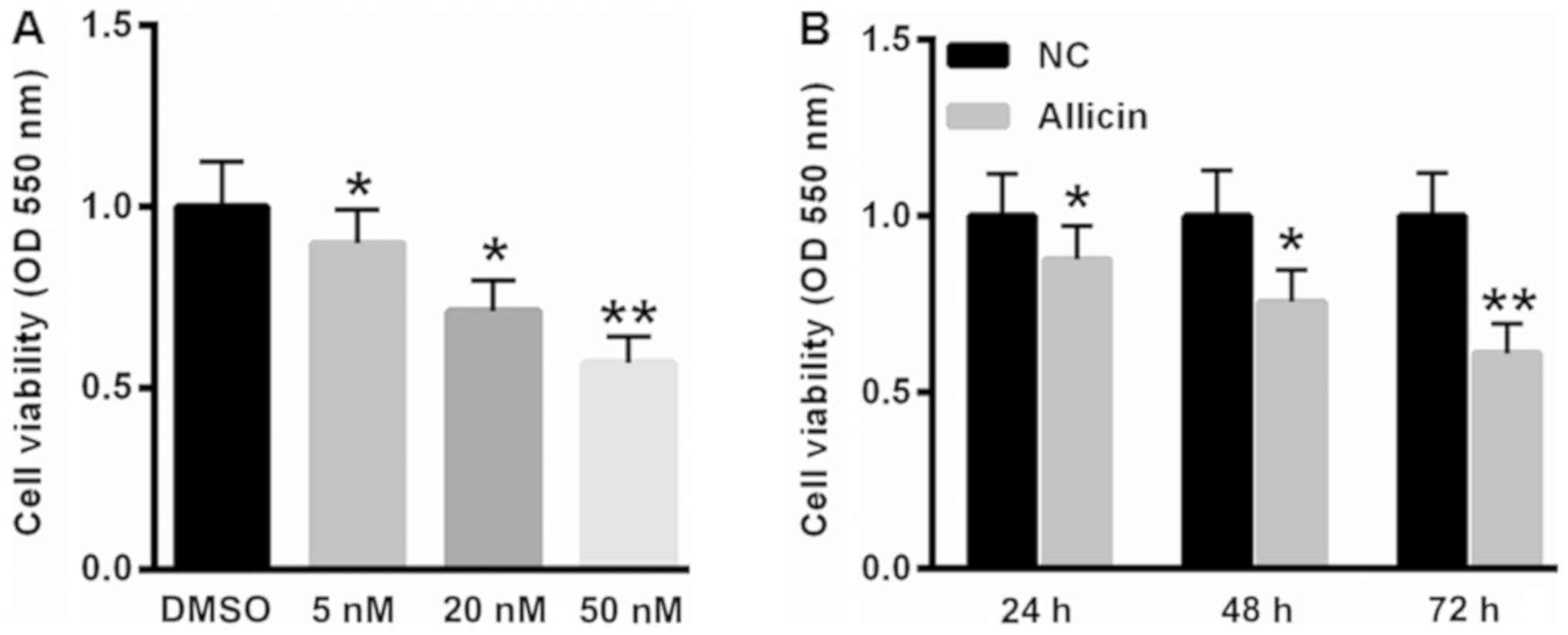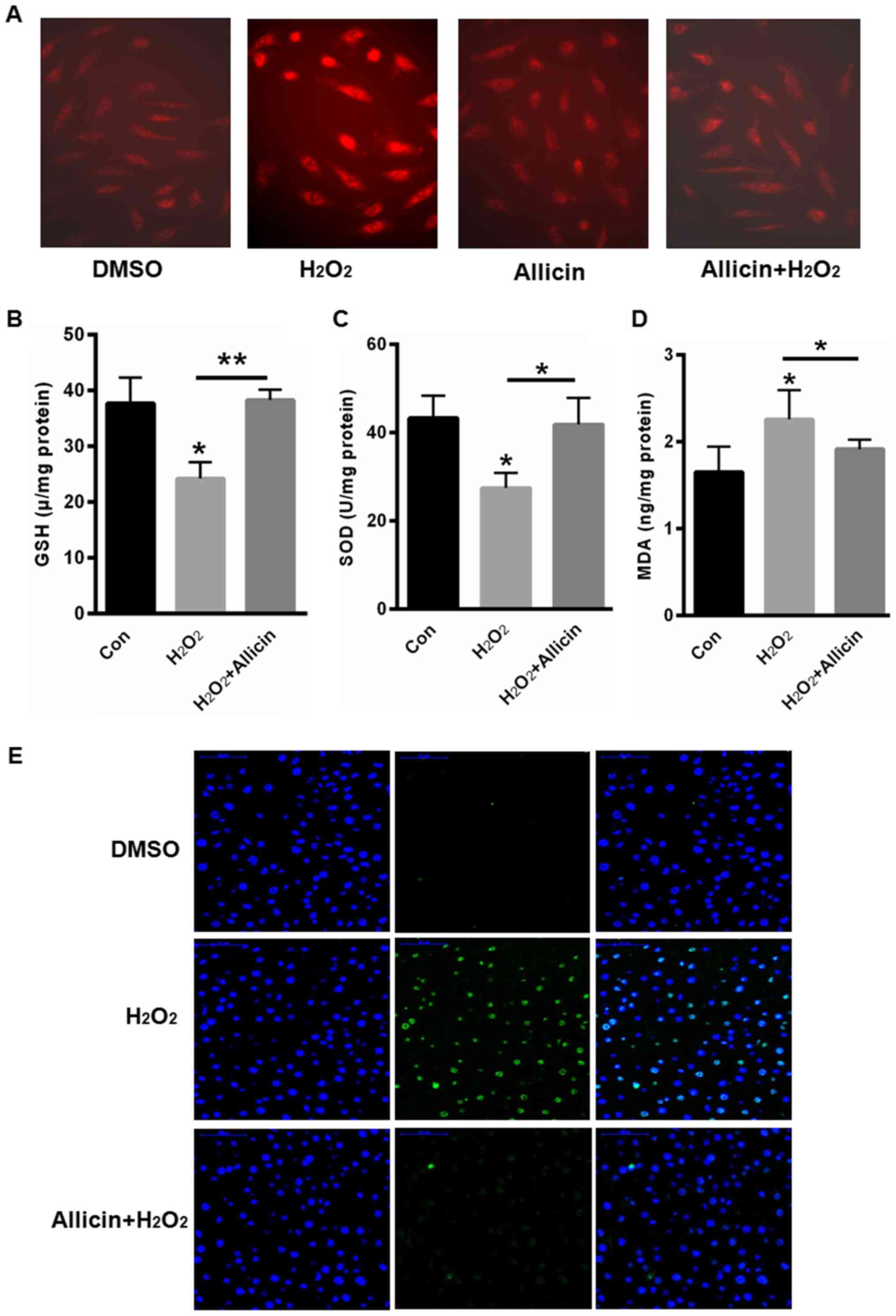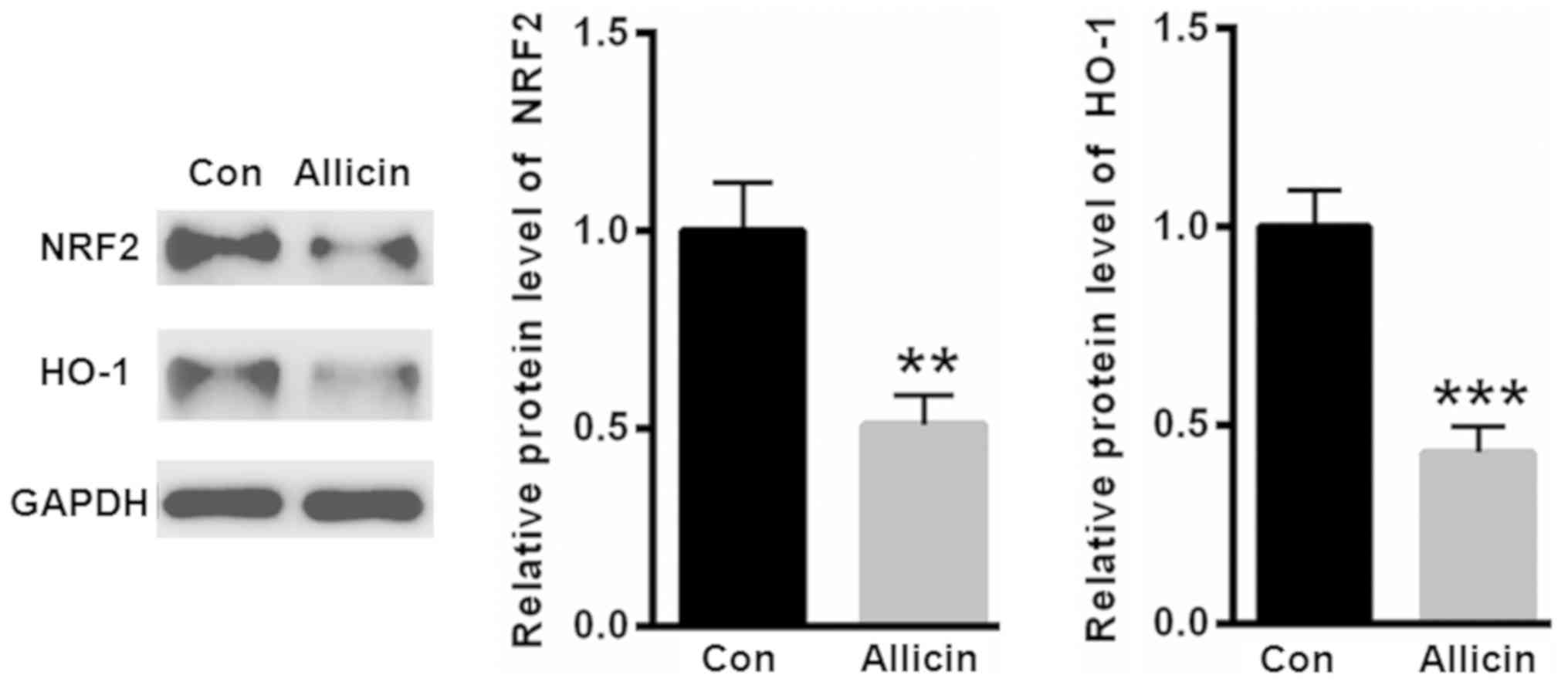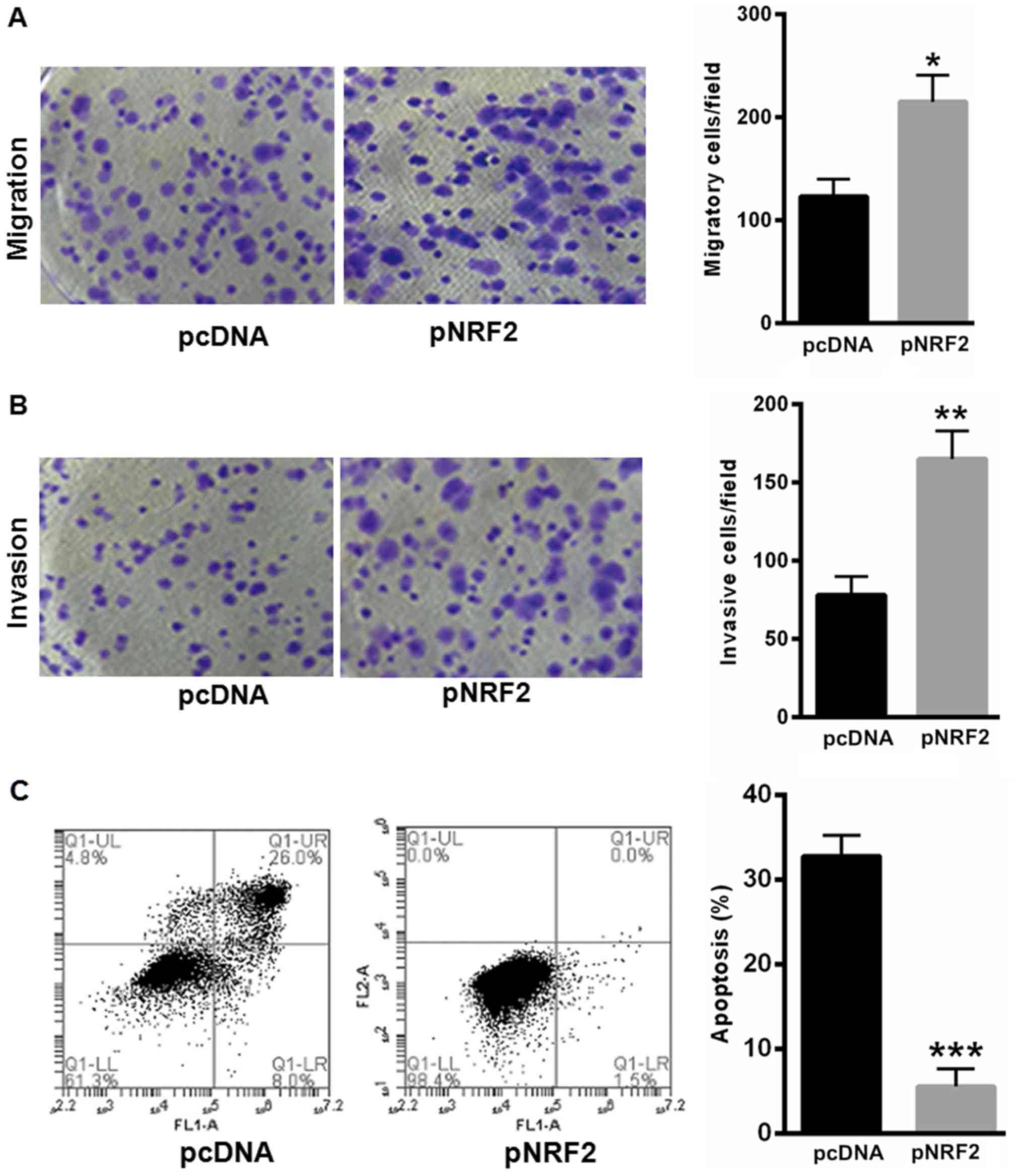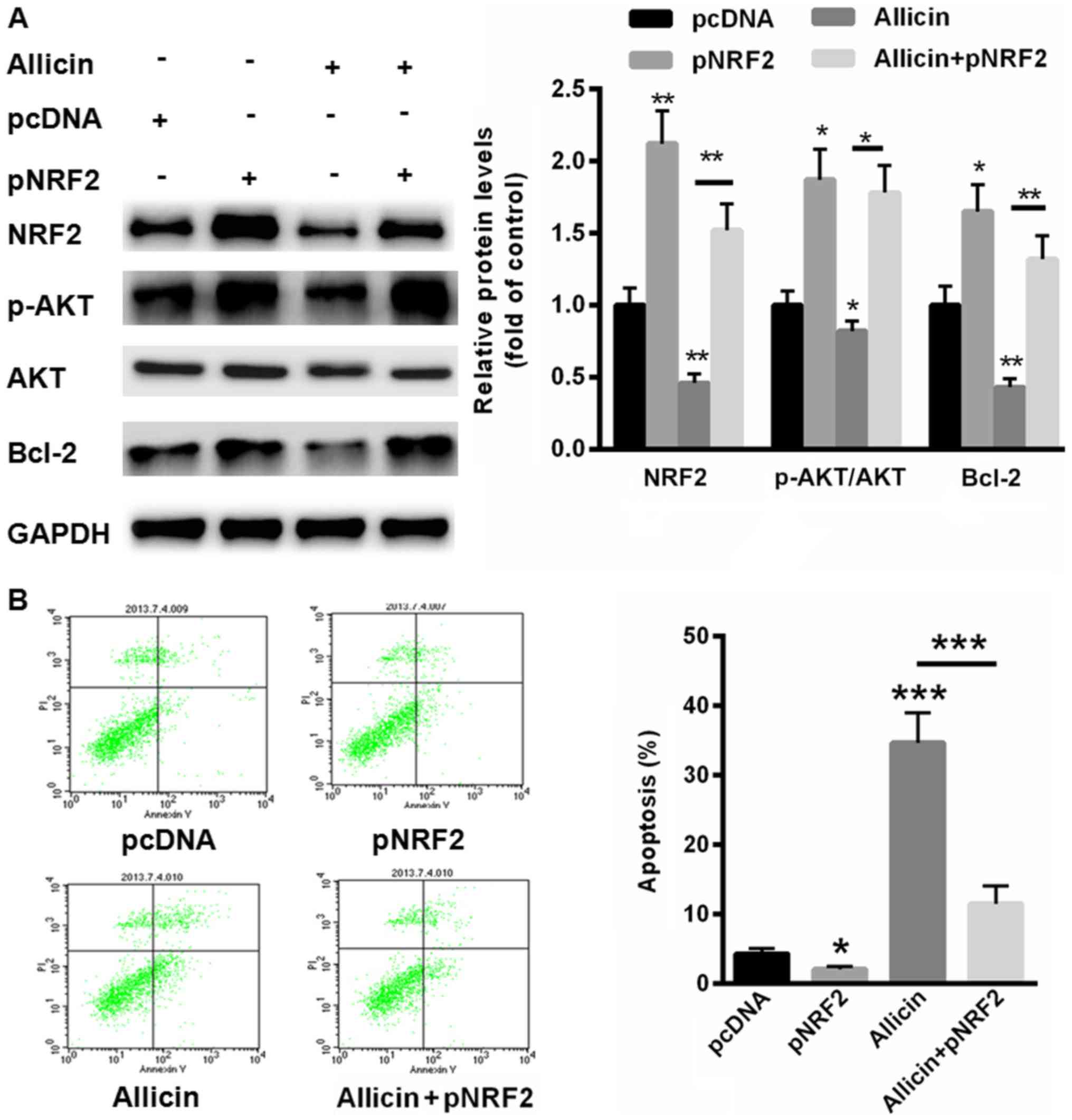|
1
|
Ma JQ, Tuersun H, Jiao SJ, Zheng JH, Xiao
JB and Hasim A: Functional role of NRF2 in cervical carcinogenesis.
PLoS One. 10:e01338762015. View Article : Google Scholar : PubMed/NCBI
|
|
2
|
Feng Y, Wang Y, Jiang C, Fang Z, Zhang Z,
Lin X, Sun L and Jiang W: Nicotinamide induces
mitochondrial-mediated apoptosis through oxidative stress in human
cervical cancer HeLa cells. Life Sci. 181:62–69. 2017. View Article : Google Scholar : PubMed/NCBI
|
|
3
|
Alvarez-Olmedo DG, Biaggio VS, Koumbadinga
GA, Gómez NN, Shi C, Ciocca DR, Batulan Z, Fanelli MA and O'Brien
ER: Recombinant heat shock protein 27 (HSP27/HSPB1) protects
against cadmium-induced oxidative stress and toxicity in human
cervical cancer cells. Cell Stress Chaperones. 22:357–369. 2017.
View Article : Google Scholar : PubMed/NCBI
|
|
4
|
Chen L, Wang L, Shen H, Lin H and Li D:
Anthelminthic drug niclosamide sensitizes the responsiveness of
cervical cancer cells to paclitaxel via oxidative stress-mediated
mTOR inhibition. Biochem Biophys Res Commun. 484:416–421. 2017.
View Article : Google Scholar : PubMed/NCBI
|
|
5
|
Souza RP, Bonfim-Mendonca PS, Gimenes F,
Ratti BA, Kaplum V, Bruschi ML, Nakamura CV, Silva SO, Maria-Engler
SS and Consolaro ME: Oxidative stress triggered by apigenin induces
apoptosis in a comprehensive panel of human cervical cancer-derived
cell lines. Oxid Med Cell Longev. 2017:15127452017. View Article : Google Scholar : PubMed/NCBI
|
|
6
|
Shah P, Trinh E, Qiang L, Xie L, Hu WY,
Prins GS, Pi J and He YY: Arsenic induces p62 expression to form a
positive feedback loop with nrf2 in human epidermal keratinocytes:
Implications for preventing arsenic-induced skin cancer. Molecules.
22:E1942017. View Article : Google Scholar : PubMed/NCBI
|
|
7
|
Bao L, Wu J, Dodson M, Rojo de la Vega EM,
Ning Y, Zhang Z, Yao M, Zhang DD, Xu C and Yi X: ABCF2, an Nrf2
target gene, contributes to cisplatin resistance in ovarian cancer
cells. Mol Carcinog. 56:1543–1553. 2017. View Article : Google Scholar : PubMed/NCBI
|
|
8
|
Cho HY, Kim K, Kim YB, Kim H and No JH:
Expression patterns of Nrf2 and keap1 in ovarian cancer cells and
their prognostic role in disease recurrence and patient survival.
Int J Gynecol Cancer. 27:412–419. 2017. View Article : Google Scholar : PubMed/NCBI
|
|
9
|
Duong HQ, You KS, Oh S, Kwak SJ and Seong
YS: Silencing of NRF2 reduces the expression of aldh1a1 and aldh3a1
and sensitizes to 5-fu in pancreatic cancer cells. Antioxidants
(Basel). 6:E522017. View Article : Google Scholar : PubMed/NCBI
|
|
10
|
Fabrizio FP, Costantini M, Copetti M, la
Torre A, Sparaneo A, Fontana A, Poeta L, Gallucci M, Sentinelli S,
Graziano P, et al: Keap1/Nrf2 pathway in kidney cancer: Frequent
methylation of KEAP1 gene promoter in clear renal cell carcinoma.
Oncotarget. 8:11187–11198. 2017. View Article : Google Scholar : PubMed/NCBI
|
|
11
|
Gonzalez-Donquiles C, Alonso-Molero J,
Fernandez-Villa T, Vilorio-Marqués L, Molina AJ and Martín V: The
NRF2 transcription factor plays a dual role in colorectal cancer: A
systematic review. PLoS One. 12:e01775492017. View Article : Google Scholar : PubMed/NCBI
|
|
12
|
Huang H, Zheng F, Dong X, Wu F, Wu T and
Li H: Allicin inhibits tubular epithelial-myofibroblast
transdifferentiation under high glucose conditions in vitro. Exp
Ther Med. 13:254–262. 2017. View Article : Google Scholar : PubMed/NCBI
|
|
13
|
Gruhlke MC, Nicco C, Batteux F and
Slusarenko AJ: The effects of allicin, a reactive sulfur species
from garlic, on a selection of mammalian cell lines. Antioxidants
(Basel). 6:E12016. View Article : Google Scholar : PubMed/NCBI
|
|
14
|
Chen X, Pang S, Lin J, Xia J and Wang Y:
Allicin prevents oxidized low-density lipoprotein-induced
endothelial cell injury by inhibiting apoptosis and oxidative
stress pathway. BMC Complement Altern Med. 16:1332016. View Article : Google Scholar : PubMed/NCBI
|
|
15
|
Ding G, Zhao J and Jiang D: Allicin
inhibits oxidative stress-induced mitochondrial dysfunction and
apoptosis by promoting PI3K/AKT and CREB/ERK signaling in
osteoblast cells. Exp Ther Med. 11:2553–2560. 2016. View Article : Google Scholar : PubMed/NCBI
|
|
16
|
Li S, Chen S, Yang W, Liao L, Li S, Li J,
Zheng Y and Zhu D: Allicin relaxes isolated mesenteric arteries
through activation of PKA-KATP channel in rat. J Recept Signal
Transduct Res. 37:17–24. 2017. View Article : Google Scholar : PubMed/NCBI
|
|
17
|
Yang D, Lv Z, Zhang H, Liu B, Jiang H, Tan
X, Lu J, Baiyun R and Zhang Z: Activation of the Nrf2 signaling
pathway involving KLF9 plays a critical role in allicin resisting
against arsenic trioxide-induced hepatotoxicity in rats. Biol Trace
Elem Res. 176:192–200. 2017. View Article : Google Scholar : PubMed/NCBI
|
|
18
|
Mahmoodi P, Motamedi H, Seyfi Abad
Shapouri MR, Bahrami Shehni M and Kargar M: Molecular detection and
typing of human papillomaviruses in paraffin-embedded cervical
cancer and pre-cancer tissue specimens. Iran J Cancer Prev.
9:e37522016.PubMed/NCBI
|
|
19
|
Kim M, Kim YS, Kim H, Kang MY, Park J, Lee
DH, Roh GS, Kim HJ, Kang SS, Cho GJ, et al: O-linked
N-acetylglucosamine transferase promotes cervical cancer
tumorigenesis through human papillomaviruses E6 and E7 oncogenes.
Oncotarget. 7:44596–44607. 2016.PubMed/NCBI
|
|
20
|
Piroozmand A, Mostafavi Zadeh SM, Madani
A, Soleimani R, Nedaeinia R, Niakan M, Avan A, Manian M, Moradi M
and Eftekhar Z: The association of high risk human papillomaviruses
in patients with cervical cancer: an evidence based study on
patients with squamous cell dysplasia or carcinoma for evaluation
of 23 human papilloma virus genotypes. Jundishapur J Microbiol.
9:e327282016. View Article : Google Scholar : PubMed/NCBI
|
|
21
|
Gu Y, Ma C, Zou J, Zhu Y, Yang R, Xu Y and
Zhang Y: Prevalence characteristics of high-risk human
papillomaviruses in women living in Shanghai with cervical
precancerous lesions and cancer. Oncotarget. 7:24656–24663. 2016.
View Article : Google Scholar : PubMed/NCBI
|
|
22
|
Zandnia F, Doosti A, Mokhtari-Farsani A,
Kardi MT and Movafagh A: Application of multiplex PCR for rapid and
sensitive detection of human papillomaviruses in cervical cancer.
Pak J Med Sci. 32:444–447. 2016.PubMed/NCBI
|
|
23
|
Müller A, Eller J, Albrecht F, Prochnow P,
Kuhlmann K, Bandow JE, Slusarenko AJ and Leichert LI: Allicin
induces thiol stress in bacteria through s-allylmercapto
modification of protein cysteines. J Biol Chem. 291:11477–11490.
2016. View Article : Google Scholar : PubMed/NCBI
|
|
24
|
Tu G, Zhang YF, Wei W, Li L, Zhang Y, Yang
J and Xing Y: Allicin attenuates H2O2-induced
cytotoxicity in retinal pigmented epithelial cells by regulating
the levels of reactive oxygen species. Mol Med Rep. 13:2320–2326.
2016. View Article : Google Scholar : PubMed/NCBI
|
|
25
|
Zou X, Liang J, Sun J, Hu X, Lei L, Wu D
and Liu L: Allicin sensitizes hepatocellular cancer cells to
anti-tumor activity of 5-fluorouracil through ROS-mediated
mitochondrial pathway. J Pharmacol Sci. 131:233–240. 2016.
View Article : Google Scholar : PubMed/NCBI
|
|
26
|
Zhang X, Zhu Y, Duan W, Feng C and He X:
Allicin induces apoptosis of the MGC-803 human gastric carcinoma
cell line through the p38 mitogen-activated protein
kinase/caspase-3 signaling pathway. Mol Med Rep. 11:2755–2760.
2015. View Article : Google Scholar : PubMed/NCBI
|
|
27
|
Jiang XY, Zhu XS, Xu HY, Zhao ZX, Li SY,
Li SZ, Cai JH and Cao JM: Diallyl trisulfide suppresses tumor
growth through the attenuation of Nrf2/Akt and activation of
p38/JNK and potentiates cisplatin efficacy in gastric cancer
treatment. Acta Pharmacol Sin. 38:1048–1058. 2017. View Article : Google Scholar : PubMed/NCBI
|
|
28
|
Kontostathi G, Zoidakis J, Makridakis M,
Lygirou V, Mermelekas G, Papadopoulos T, Vougas K, Vlamis-Gardikas
A, Drakakis P, Loutradis D, et al: Cervical cancer cell line
secretome highlights the roles of transforming growth
factor-beta-induced protein ig-h3, peroxiredoxin-2 and nrf2 on
cervical carcinogenesis. Biomed Res Int. 2017:41807032017.
View Article : Google Scholar : PubMed/NCBI
|
|
29
|
Krajka-Kuźniak V, Paluszczak J and
Baer-Dubowska W: The Nrf2-ARE signaling pathway: An update on its
regulation and possible role in cancer prevention and treatment.
Pharmacol Rep. 69:393–402. 2017. View Article : Google Scholar : PubMed/NCBI
|
|
30
|
Lisek K, Walerych D and Del Sal G: Mutant
p53-Nrf2 axis regulates the proteasome machinery in cancer. Mol
Cell Oncol. 4:e12179672016. View Article : Google Scholar : PubMed/NCBI
|
|
31
|
Lu K, Alcivar AL, Ma J, Foo TK, Zywea S,
Mahdi A, Huo Y, Kensler TW, Gatza ML and Xia B: NRF2 induction
supporting breast cancer cell survival is enabled by oxidative
stress-induced DPP3-KEAP1 interaction. Cancer Res. 77:2881–2892.
2017. View Article : Google Scholar : PubMed/NCBI
|
|
32
|
Mandal A, Bhatia D and Bishayee A:
Anti-Inflammatory mechanism involved in pomegranate-mediated
prevention of breast cancer: the role of NF-κB and Nrf2 Signaling
pathways. Nutrients. 9:E4362017. View Article : Google Scholar : PubMed/NCBI
|















